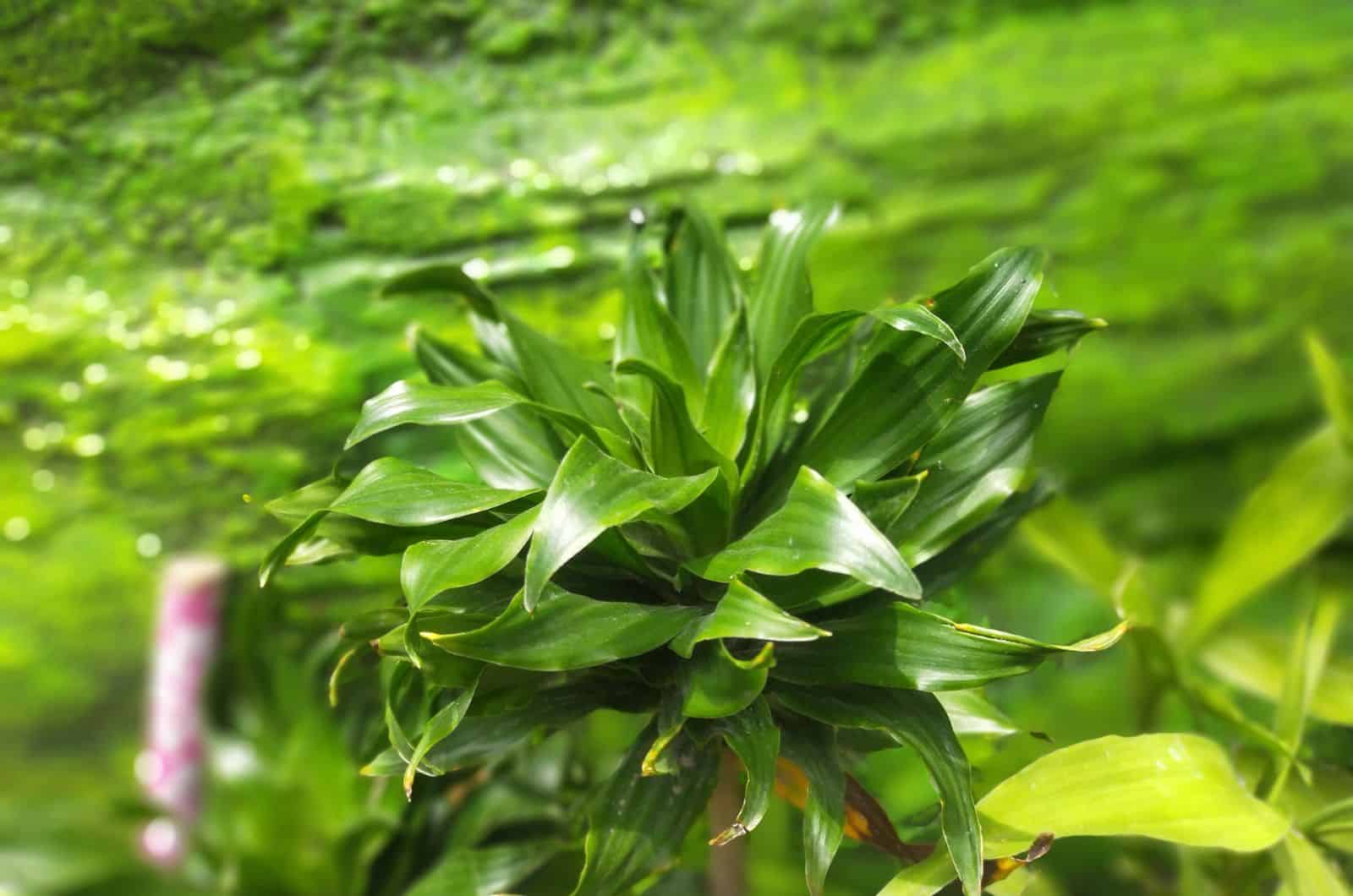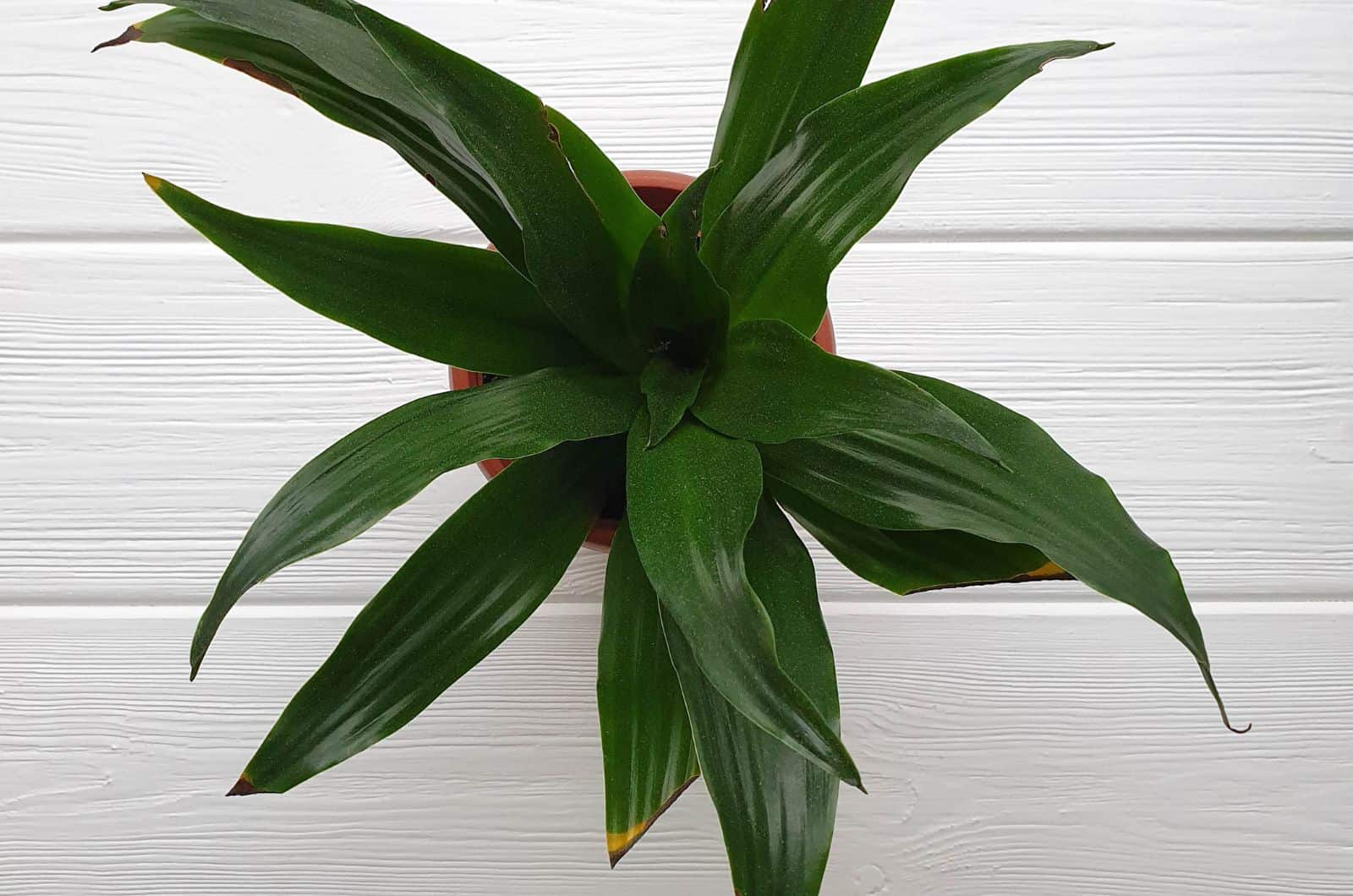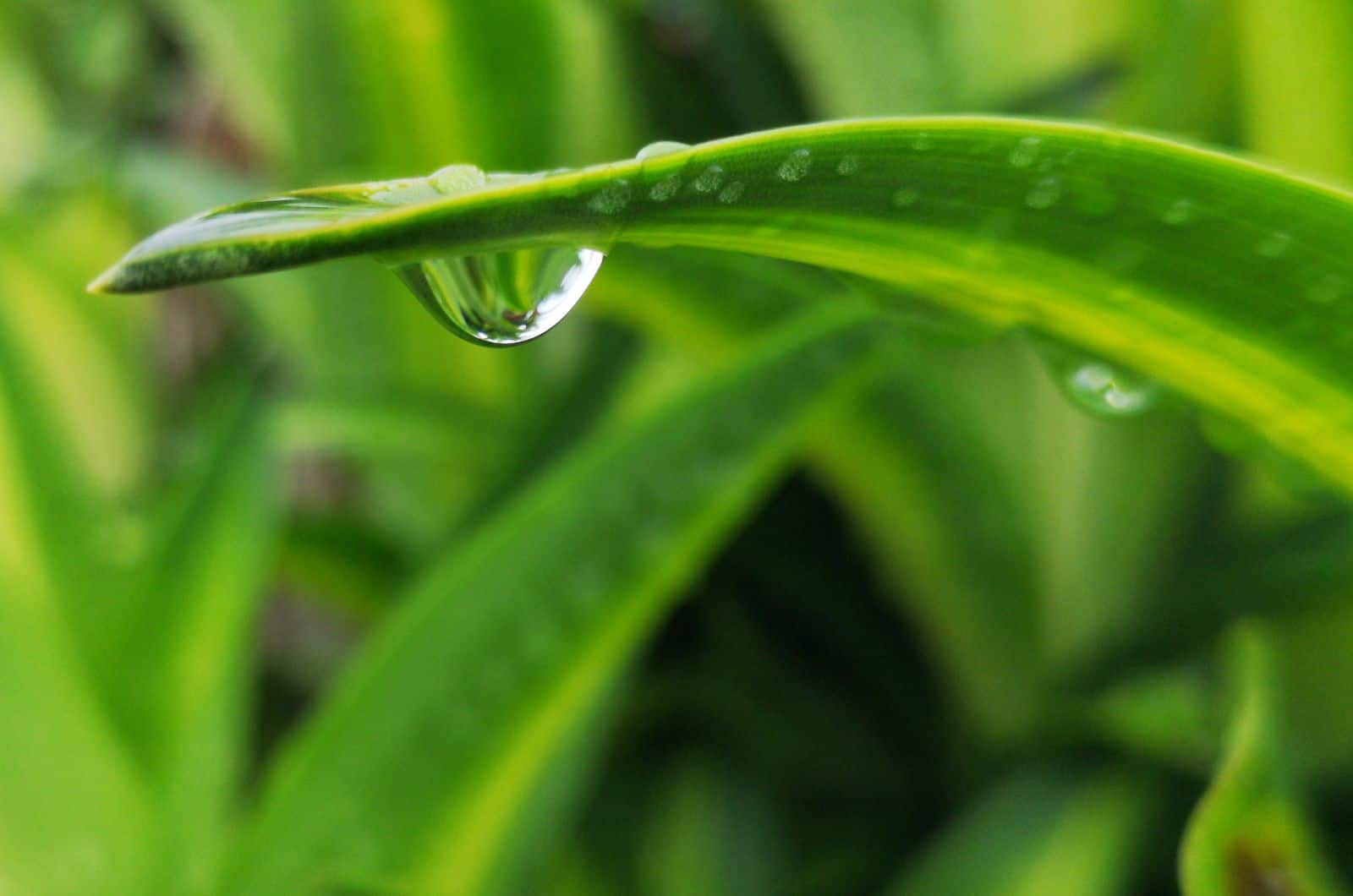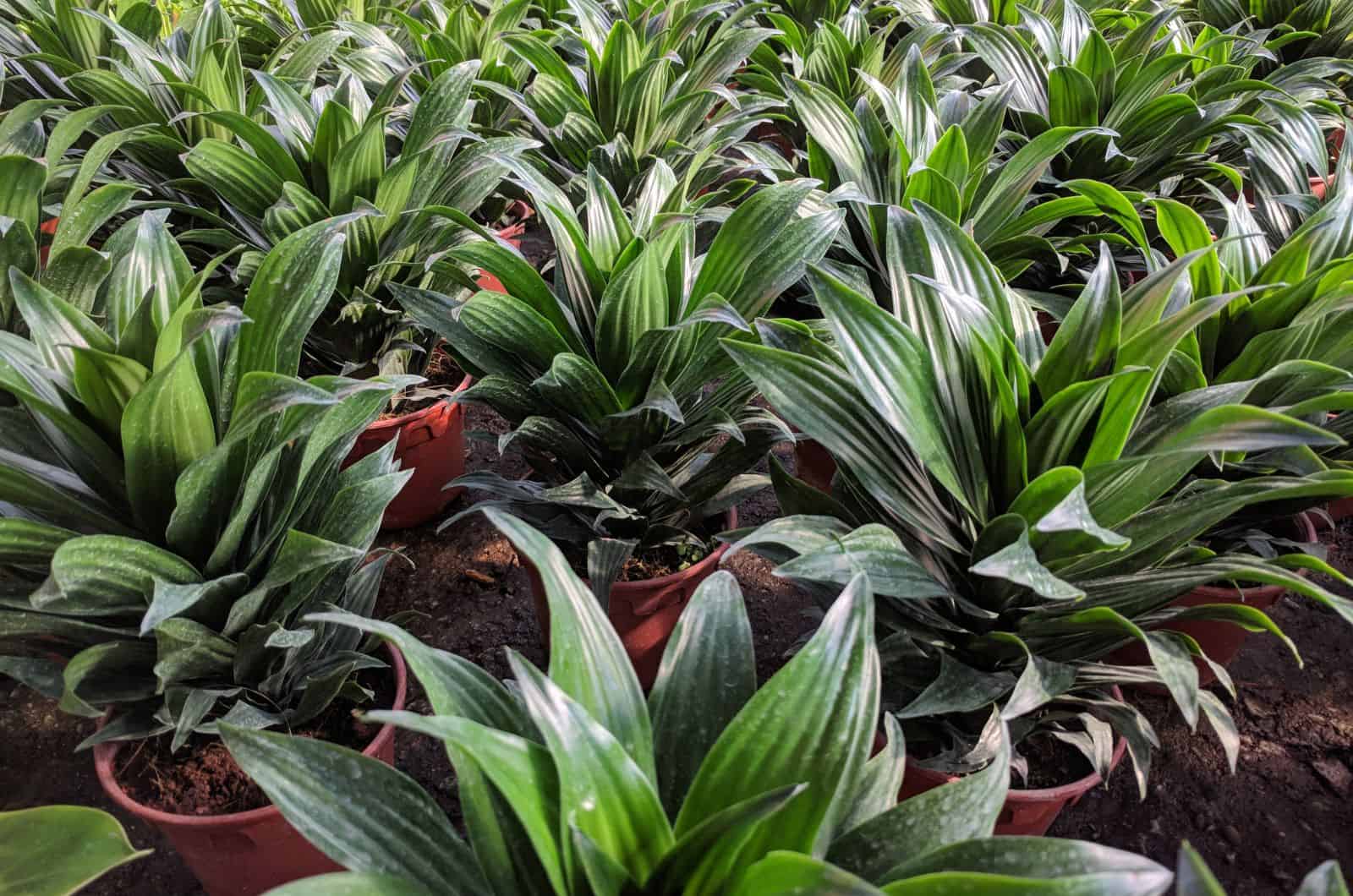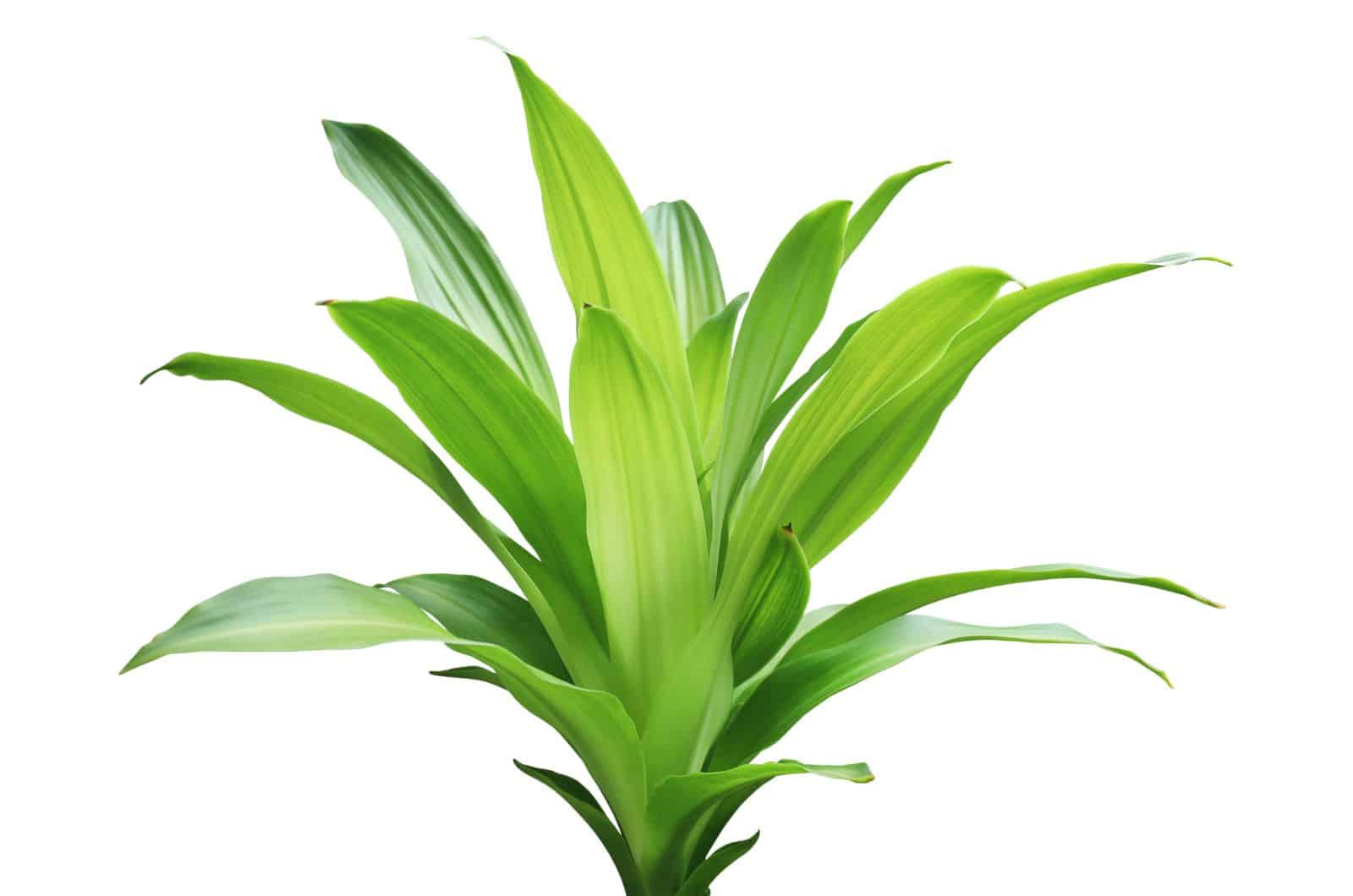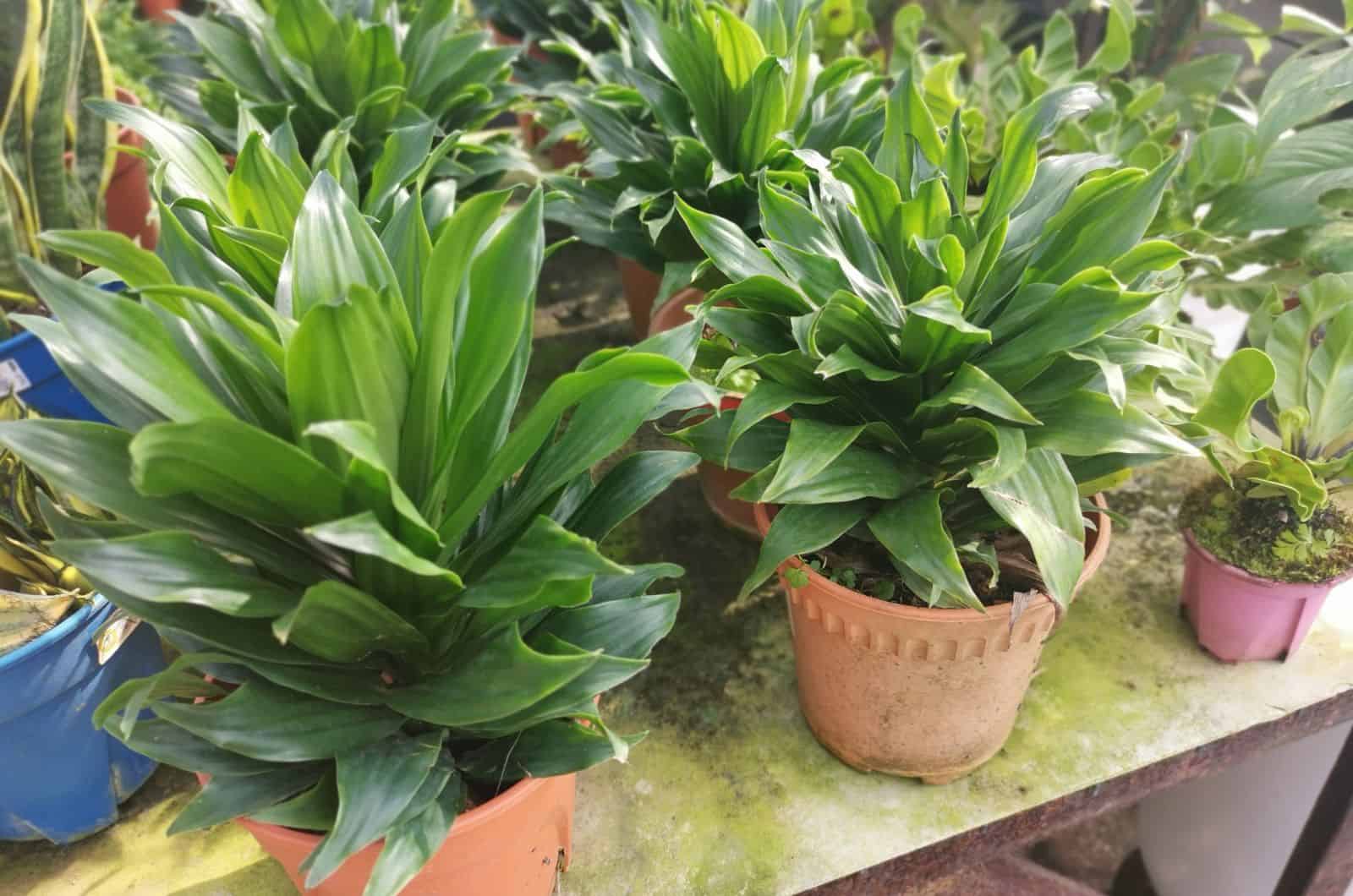It can be said that Dracaena plants are old-school plants, as they have been grown for a long time. If you are a beginner and ask an experienced plant grower if a Dracaena variety is a suitable plant, their answer will be definitely yes.
Why is that so? These plants are low-maintenance, and as such, they are a good choice for every grower.
Dracena is a large genus in which you can find over 120 species, and the Janet Craig is one of the most common (and most beautiful) species. Today, I will tell you more about its sport, the Janet Craig compacta.
Keep reading to discover what a sport of plants is and learn all about the Dracaena Janet Craig compacta.
Before we move on, here’s some basic info.
| Family | Asparagaceae |
| Genus | Dracaena |
| Scientific name: | Dracaena deremensis Janet Craig compacta |
| Common names: | Dwarf Dracaena, compacta Janet Craig, pineapple Dracaena, Dracaena compacta |
| Native habitat: | Sub-tropical regions of Asia and Africa |
| Plant type: | Evergreen, perennial |
| USDA hardiness zones: | 10–12 |
Let’s get started!
What Does The Janet Craig Compacta Look Like?
What makes this plant different from other Dracaenas? I mentioned that it’s a sport of the Dracaena Janet Craig.
This means that the plant shares the body features of the parent plant but differentiates in morphology.
The compacta Janet Craig is a dwarf variety and can grow up to 6 feet, while the parent plant may reach 15 feet.
Let’s learn more about its appearance!
Leaves & Flowers
The glossy, dark green leaves with pointy leaf tips make this floor plant unique and beautiful. The leaves usually reach 5 inches in length in their mature stage.
The bright pink flowers grow from the compacta Janet Craigs’ rosette. Don’t worry if you don’t see the plant bloom as it is not really very common to see flowers when this plant is grown indoors.
Growth Rate And Habit
This plant may be the slowest grower of slow-growing plants that I know of (and I know a lot of them).
If it reaches 4 inches yearly, be very happy as this is the fastest it can grow.
The Benefits Of A Janet Craig Compacta Plant
The compacta Janet Craig is an air purifier, according to NASA research. It’s a good idea to grow at least one Janet Craig in your home as they remove harmful substances from the indoor air, such as formaldehyde and benzene.
Another benefit of this plant is that it is extremely easy to grow. Just like its cousin, the Dracaena fragrans (corn plant), it won’t take up much of your time, and it will be happy even if it’s neglected a little bit.
Is A Janet Craig Compacta Toxic?
Yes, it’s toxic, just like all plants from this genus, and this is probably the only drawback of this plant.
The leaves contain toxic substances, and if you ingest them, you can face issues such as mouth/throat swelling or diarrhea.
However, many houseplants are toxic, and as long as you keep them out of reach, especially of children and pets, they can be grown indoors.
Care Guide For The Dracaena Janet Craig Compacta
Now it’s time to find out how to keep a compacta Janet Craig healthy!
Take a look at the table below for an overview of its care requirements.
| Light: | Low to medium |
| Temperature: | 65 to 80 °F |
| Humidity: | Moderate |
| Watering: | Moderate |
| Soil: | Well-draining, porous, fertile |
| Fertilizing: | Low requirements |
| Pruning: | Optional |
| Cleaning: | Monthly |
| Repotting: | Every 3–4 years |
Light Requirements
The vast majority of houseplants grow best in bright indirect light, and the compacta Janet Craig isn’t an exception.
What makes this plant different to other common houseplants is its low light tolerance. Actually, this is one of the only plants that will thrive and grow healthily in low light.
But, light that’s too low may stunt its growth, so pay attention to this.
It’s pretty easy to ensure adequate light conditions as you can choose between low and medium light levels.
However, one of the biggest enemies of a Janet Craig is direct sunlight. Some indoor plants may benefit if exposed to direct sun for a short period.
This is not the case with a Janet Craig. It will not only suffer from sunburns and scorching and curling leaves, but it could also die quickly.
So, when finding a perfect spot for your Janet Craig, exclude all places that receive any amount of direct sunlight.
For example, windowsills aren’t suitable for this plant.
Where To Place A Janet Craig Dracaena?
As I said, direct sunlight isn’t an appropriate light for these plants. The windows that receive the highest amount of direct sun rays are south-facing windows.
If you put your Janet Craig too close to one of these windows, the rays will touch the delicate leaves of the Janet Craig directly.
But, if you can’t provide any other spot, use curtains (sheer) on the windows. It will prevent the direct sun from reaching the leaves, and your Janet Craig will receive some bright but indirect sunlight.
Another problem with a south-facing window is the temperature. Of course, the temperature is higher, which increases the plant’s need for water. Therefore, it’s easier to underwater your Janet Craig if its placed near to this window.
A similar situation is with a west-facing window; however, the amount of direct sun is lower. So, it’s not a perfect window for a Janet Craig either. But, if you have to choose between south and west, choose the west-facing window.
An east-facing window receives direct sunlight but only in the morning; the sun isn’t intense, so your Janet Craig will benefit from a little bright light. Don’t forget to check on your plant and see how it reacts to this exposure.
Finally, a north-facing window is a pretty good choice for your Janet Craig as it never receives direct sun. The only problem is winter, when the light level is too low.
Luckily, there is a solution: use grow lights and a light meter to monitor and keep the light level optimal.
Temperature Requirements
Your Janet Craig will perform best if grown at temperatures ranging from 65 to 80 degrees Fahrenheit.
My Janet Craig plant grew well in slightly lower temperatures. Still, I noticed some changes when temperatures dropped below 50 degrees Fahrenheit.
So, I wouldn’t recommend going below 50 degrees as you may have to deal with a drooping Janet Craig Dracaena.
Also, pay attention to the thermostat and make sure that the temperatures aren’t too high.
If you notice wilting and the plant appears to be dying, it might be suffering from a temperature shock.
Temperatures aren’t a tricky part of plant care, but fluctuations or sudden changes may cause issues.
Never place your Janet Craig near radiators, heating vents, or fireplaces.
The same goes for cold drafts; A Janet Craig will respond by drooping and wilting when placed near air-conditioners and drafty windows!
Humidity Requirements
Although the Janet Craig Dracaena tolerates different levels of humidity, I recommend that you aim for moderate to higher humidity levels.
Bear in mind that this is a tropical plant, so it naturally got used to a higher humidity. Yes, it’s adaptable and pretty hardy but it won’t take extreme deviations well.
A humidity of 60% is the lowest you can go with. As you may assume, typical household humidity levels aren’t this high, so you’ll need to increase them a little bit.
Experienced growers, such as myself, recommend increasing humidity using one of the natural methods. I’ll show you each, but I’ll also show you one method perfect for technology lovers.
How To Increase Humidity?
Grouping plants together is an excellent strategy that you can employ to address a low humidity issue.
This is effective because the plants such as a Janet Craig will take up the moisture that the other plants release. So, if you grow the parent Janet Craig, place its sport variety, compacta, near.
However, remember that plants should not be placed too closely together, especially when you are grouping them. To prevent illnesses, they require enough air circulation. Also, if the leaves are crowded together, pests and illnesses could spread more easily.
Another method that will certainly help you to increase humidity is misting. When misting, don’t forget about the undersides of the leaves. The only problem with this method is that it doesn’t last long, so if you decide to use the misting method, do it frequently if you want it to work.
Place a pebble tray underneath a Janet Craig plant’s pot, or place your plant in a larger pot and put sphagnum moss in it. Make sure the sphagnum moss is wet all of the time.
Now, let’s discuss the method for technology lovers; using a humidifier is probably the safest method for your Janet Craig to receive enough humidity. The great thing is that you can also monitor humidity if you use this device!
Watering Schedule
To fulfill all the watering needs of your Janet Craig, you’ll need to pay attention to a couple of things.
First, you need to know when to water it as too frequent watering may damage the plant as much as not watering it enough.
Second, the watering technique also matters as it is a great way to avoid overwatering and underwatering.
Believe it or not, the water type may affect the overall health of this Dracaena, so choose wisely when it comes to this.
Let’s get into the details!
When To Water
The biggest lie someone can tell you when it comes to watering a Janet Craig Dracaena compacta is to water it every two weeks.
Not only does it not work, but it could also lead to severe issues related to the plant’s health.
How come? The time the soil needs to dry out depends on many factors. The problem is that you can’t leave the soil to dry out. So, more light and higher temperatures increase the watering needs.
This plant prefers moist soil and requires watering when its topsoil dries 2 inches below the surface.
You should check the soil moisture content regularly. You can use your fingers to detect the moisture level; insert your fingers and feel the moisture. Don’t worry; your fingers won’t be dirty for long. Over time, you’ll know exactly when your plant needs water.
Another technique is observing the soil color. Yes, you read it right; the darker the soil, the more moisture it contains and vice versa.
You can also lift this dwarf plant and check the content; the heavier the pot, the more moisture it has.
And, of course, I have something for technology lovers. Use a moisture meter to detect the moisture content. Again, this is the safest way to determine your plant’s needs.
How To Water
Why is a watering technique needed, and what does this even mean? This refers to the way that you’ll water your compacta Janet Craig. One way is to water it from the top, meaning you’ll water the topsoil, not the leaves!
Thoroughly water your plant until you notice that the excess water is running from the drainage holes.
Another method, and the one that I recommend, is bottom watering. This method refers to placing your Janet Craig Dracaena compacta in a sink that has previously been filled with water.
Let the Janet Craig plant’s soil gradually absorb the water and then take it out and leave it to drain.
The second method prevents the excess water from pooling in the pot. Later, we will discuss how overwatering may damage the plant, so stay tuned!
Type Of Water
Finally, it’s time to close the section about watering by discussing the water type that’s perfect for this Dracaena deremensis plant.
Although tap water sounds like the easiest way to go, it should be the last option. You know that tap water may contain a higher concentration of fluoride and chlorine, which could damage or even kill your plant.
So, what is the best water for this plant? I suggest you use rainwater; if you can’t provide this, go with distilled water instead.
Soil
The perfect soil for this Dracaena plant should be:
• Well-draining: your goal is to help the excess water come out.
• Porous: the root system needs good air circulation for the roots to breathe.
• Fertile: more than 50% of organic matter is required for the Janet Craig plant’s healthy growth.
I’m sure you are wondering if you can purchase a ready potting mix for this plant. Yes, you can, and the best option is to buy the one made for African violets.
You can also make perfect soil yourself. You’ll need regular potting soil (available in all nurseries that sell live plants), compost, and perlite. Or, you can use peat moss instead of potting soil.
Why these ingredients? Compost will make the soil fertile, perlite will improve drainage, and potting soil or peat moss will aid in water retention. Adding vermiculite or coco coir is also a good idea.
Fertilizing
This slow-growing plant isn’t a heavy feeder, and you don’t need to feed it whatsoever.
I know that you would like to promote growth, so if you do decide to feed your Janet Craig compacta, don’t worry; it won’t damage the plant if you stick to a perfect schedule and use a perfect fertilizer type.
The growing season for this sport variety lasts from spring to fall; fertilize monthly and stop fertilizing once the fall arrives.
These plants enter dormancy in the fall and don’t need food.
When it comes to the fertilizer type, I recommend a liquid, all-purpose fertilizer made for houseplants.
Please stick to the instructions on the fertilizer package and pay attention to the schedule!
Pruning & Cleaning
As mentioned, this is a slow-growing plant, so don’t expect new leaves to grow quickly. This is also the reason why pruning isn’t required for these plants.
Of course, you should cut off the unhealthy leaves after determining what has caused the changes. Bear in mind that some leaves may turn yellow or droop because of their age, so don’t panic if you spot some discoloration.
Cleaning should be a part of regular plant care, even though some growers don’t agree. Dust has no benefits, so why don’t you remove it monthly? The leaves will be shiny, and it’ll be easier to spot any other changes.
Also, don’t use any commercial products for cleaning the leaves; water and a soft sponge do wonders!
Repotting
You may assume that this plant doesn’t require frequent repotting. This is also one benefit of slow-growers, especially if you don’t like getting your fingers covered in soil.
However, sometimes you’ll need to repot your Janet Craig plant if there are some diseases present, such as root rot.
Once the time for repotting arrives, you need to know how to do it. First, you need to know when to repot; the easiest sign to spot is the roots coming out the drainage holes.
This means that they don’t have enough space to grow.
Here are the steps for how to repot this plant!
• Remove your Janet Craig compacta from the pot. Be careful and don’t damage the roots or break any other part of the plant. The easiest way to avoid this is not to pull the plant but rather let it slide out after you’ve leaned the pot to one side.
• Now, remove as much soil from around the Janet Craig roots as possible. Inspect each root; if any of them are discolored (brown or black) or mushy, please remove them with sanitized scissors.
• Pay attention to pot size; purchase one that’s two inches larger than the current one and make sure that it has enough drainage holes.
• Fill the new pot with fresh soil (I described the perfect soil type above) and place your dwarf Dracaena in the center.
• Water the plant and put it where it can get enough indirect sunlight. Remember that it takes time for the plant to adapt, so be patient!
How To Propagate A Dracaena Deremensis Janet Craig
When growing plants with features such as the compacta Janet Craig, it’s completely logical to want more of such plants.
You’ll expand your plant collection by adding one more air purifier and low-maintenance plant.
There are two propagation methods for the compacta Janet Craig, top cuttings and bottom cuttings.
Let’s see both!
Top Cuttings
Believe it or not, you can get a new plant by removing the top of the parent plant. It may sound like killing the old one to get the new plant, but that’s not the case.
Yes, you remove the top of the plant, but it ‘recovers’ quickly; you’ll notice new growth very quickly.
For the top cutting propagation method, prepare the following:
• A healthy compacta Janet Craig
• A pair of sanitized, sharp scissors or any other cutting tools
• A transparent vase/jar
• New pot
• Fresh Soil
• Water
1. Search for a compacta Janet Craig’s leaf line and make a cut just below. Don’t forget to select the part that contains nodes.
2. Fill a transparent vase/jar with fresh water and immerse the bottom part of the cuttings in it. You can plant these cuttings in the soil without placing them in water. However, water propagation speeds up the process.
3. To prevent rotting, refresh the water regularly.
4. Once the roots are long enough, you can plant them in the soil that you prepared earlier.
5. Place the Janet Craig’s cuttings in indirect light. Once you spot the new growth, continue with its usual care.
Stem Cuttings
The stem cutting method is one of the most popular methods used for indoor plant propagation.
It’s simple, straightforward, and suitable for beginners.
Here are the steps:
1. Make a four-inch stem cutting that has at least one node attached. Use sharp and sanitized cutting tools.
2. Remove the lower leaves before placing the cutting in water unless you want them to rot and fail to develop new roots.
3. Put the cuttings in the water and don’t forget to change the water about 2–3 times a week.
4. Once the new roots sprout, transplant the cuttings into a new pot filled with fresh soil.
5. Place the pot in indirect light.
Common Issues
Beginner growers often think that low-maintenance plants can’t face any issues; they are easy to maintain, aren’t they?
A compacta Janet Craig may face different issues, but if you react on time, you can be the hero and save your plant.
Let’s start!
Brown Tips
The most common issues related to a compacta Janet Craig are brown leaf tips.
There are three possible culprits for brown tips: overwatering, direct sunlight, and low humidity. What to do? First, change the watering schedule. Let the soil dry enough, and then water the plant.
Check the light level if the compacta Janet Craig is still developing brown leaf tips. If it receives enough and not too much light, consider increasing humidity using the tips I gave you above.
Diseases
Although some diseases may be detrimental to the plant, spotting them on time increases the chances of recovering it.
Let’s see the most common diseases that affect a compacta Janet Craig!
Downy Mildew
If the leaves of your plant are drooping or you notice chlorosis and holes in the leaves, check if your plant has downy mildew.
The most common cause of this disease is constantly wet leaves. Remember that the leaves are delicate, and no water drops should be on them.
The best way to avoid this disease is by ensuring enough air circulation. You can use fungicides to ‘cure’ the disease in its early stages.
Powdery Mildew
White spots on the plants aren’t an uncommon sight to growers. The most common cause of these kinds of spots is powdery mildew.
Too high humidity and too frequent misting often cause this disease. Therefore, use a humidifier that controls humidity levels and pay attention to not mist too frequently.
Root Rot
I’m sure you’ve heard of root rot disease at least a hundred times, even if you are a beginner. If the soil of your compacta Janet Craig is waterlogged, it will attract fungus.
You’ll notice yellow leaves and mushy soil when the fungus starts spreading. The best way to get rid of this disease is by repotting your plant and removing the diseased roots before placing the plant in new soil.
Pests
It’s worth mentioning that this Dracaena isn’t prone to pests, but the ones that may come by are mealybugs, spider mites, and scales.
Let’s see how to spot them and get rid of these creatures!
Mealybugs
Mealybugs frequently visit houseplants.
You must take action at once to prevent the spread of these small insects, which may be recognized by a white substance on the stems.
The best way to get rid of them is to rub neem oil or alcohol on the leaves.
Spider Mites
If you spot white or brown spots on a Janet Craig’s beautiful leaves and you also notice webbing; spider mites are most probably the culprits.
If the infestation is severe, your compacta Janet Craig will display stunted growth. It already has a slow growth rate, which is why it’s hard to spot if it’s dealing with pests.
Remove them by rubbing neem oil or rubbing alcohol on the leaves.
For Those Who Want To Know More
I’m sure you’ve wondered why on earth this plant is called a Janet Craig! When I heard about the plant for the first time, my first thought was that it was named after some singer or artist.
Of course, it is named after someone more concerned with botany. The plant got its name after the daughter of a nurseryman, Robert Craig.
Luckily, most other plants don’t have such names, and I’m not sure that I would be thrilled if my other favorite plants were named Monicas or Johnattans. I prefer names like Philodendrons and Aglaonemas.
Dracaena originates from the Greek’ drakaina; in English, that would be a female dragon.
It’s also considered a lucky plant, so if you are into Feng Shui, this plant is a good choice.
Wrapping Up
The Janet Craig compacta is a great choice as a houseplant. It’s low-maintenance, purifies the air, and looks remarkable.
The only drawback is that it’s toxic, so you might want to pay more attention to where you place it, especially if you have small children and curious pets.
I think it’s time for you to go and get yourself at least one Janet Craig (I mean plant).
Until next time!
Like this post? Share or pin it for later!

